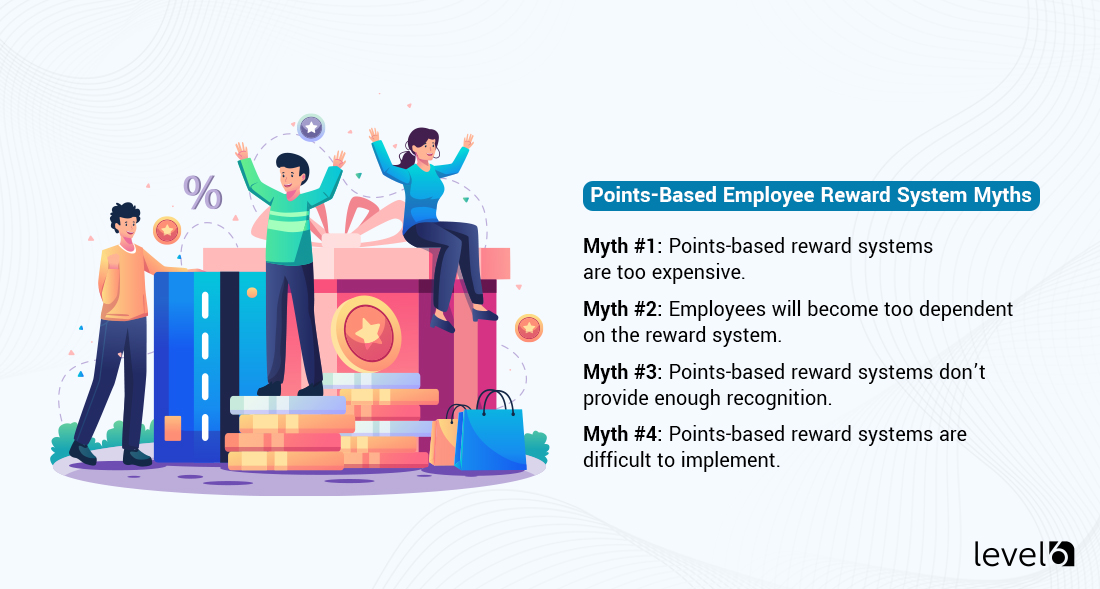Are you considering implementing a points-based employee rewards system in your workplace? This can be a great way to recognize and reward your employees for their hard work.
But before diving in, it’s important to weigh the pros and cons of such a system. In this blog post, we’ll explore the advantages and disadvantages of a points-based employee rewards system and how to get the best return on investment.
We’ll also look at how to make sure your employees are getting the most out of the rewards system.
What is a Points-Based Employee Reward System?
A points-based employee reward system is an incentive program that rewards employees for achieving specific goals, completing projects, or exhibiting exceptional performance. In these programs, employees can earn points for their accomplishments in much the same way as customers do with loyalty programs.
The more points the employee earns, the more they feel noticed and then rewarded. Points can be redeemed for a variety of rewards, such as gift cards, extra vacation days, or company swag. Employees can even donate their points to a charity.
Employee rewards programs can involve a small department or the entire team. A points-based system gives employers the flexibility to customize their rewards to meet the needs and preferences of their employees.
Instead of having only managers make reward decisions, co-workers nominate their peers. Management can still have the final say, but this allows for a little friendly competition and a lot of excitement. Knowing there’s an opportunity to be rewarded keeps everyone on their toes, and you’ll even see a bump in productivity.
Points-based reward systems are popular among companies because they are relatively inexpensive and provide incentives for employees to work harder and be more productive. They are also easy to implement and manage since most points-based systems come with online tracking tools. This allows employers to quickly and easily view which employees are earning points and what rewards they are redeeming.
Why Do Points-Based Reward Systems for Employees Work?
Points-based reward systems for employees can be incredibly effective at motivating and rewarding performance. This is because they are designed to provide tangible rewards to employees in exchange for achieving their goals or meeting expectations.
Looking to learn more about an incentive, rebate
or reward program for your business?
Curious about costs?
Try our instant pricing calculator:
The key to a successful points-based employee reward system is understanding why it works. For starters, it encourages employees to strive to reach their goals by providing incentives for them to do so. It also incentivizes them to achieve more since they are rewarded with points that they can redeem for prizes or benefits.
The system allows managers to keep track of each employee’s progress and reward them accordingly while also allowing them to adjust the incentives as needed. It is also relatively easy to implement and manage, which makes it an ideal choice for many businesses.
Moreover, the system is completely flexible and can be tailored to fit any company’s budget and specific needs. And, since points can be redeemed for items such as gift cards, discounts, and special offers, it allows businesses to reward their staff without breaking the bank.
Overall, a points-based reward system can be an effective way to motivate and reward employees. The key is finding the right balance between rewards and expectations that will work best for your business.
Most Popular Points-Based Employee Reward Systems
The most popular types of points-based employee reward systems include:
Cash Back Programs – These reward employees with a percentage of their purchase price after they have earned a certain number of points. These cash-back rewards can be given in the form of gift cards, which is the most valuable type of reward. This can be store-specific (Best Buy, Amazon, Walmart, etc.) or, even more popularly, a VISA-type gift card that allows purchases from anywhere the employee chooses, giving them the freedom to choose between merchandise or an experience.
Reward Point Programs – In these programs, employees receive points based on a pre-determined value for each task they complete or goal they meet. The points can then be redeemed for rewards like gift cards or merchandise. Creating an online catalog specifically for your company’s employees gives you an opportunity to brand the merchandise with your company logo for added advertising advantages.
Discount Programs – Employees receive a discount when they have earned a certain number of points.
Loyalty Programs – With loyalty programs, employees are rewarded for their ongoing loyalty to the company. They may receive points for participating in surveys, writing reviews, and referring friends.
Time Off Rewards – These reward employees with paid time off for reaching certain milestones or accomplishing specific tasks.
Do’s and Don’ts of Points-Based Employee Reward Systems
Here are the dos and don’ts you’ll need to know in regard to points-based employee reward systems:
- Do establish clear rules and regulations to ensure employees know the boundaries of their rewards system.
- Do develop a points-based employee reward system that is tailored to meet the individual needs of each employee.
- Do embrace digital technologies for managing, tracking, and redeeming points-based rewards.
- Do consider creating tiers or levels that require employees to reach certain milestones before they can unlock bigger rewards.
- Do use analytics and data to measure the effectiveness of your rewards system and make changes as needed.
- Don’t create a points-based reward system that is too complicated or difficult to understand.
- Don’t neglect to communicate how points are earned, tracked, and redeemed with employees.
- Don’t limit point-earning opportunities to only a few select activities or tasks.
- Don’t make rewards unattainable for lower-performing employees or create disparities in earning potential.
- Don’t forget to recognize smaller accomplishments in addition to bigger successes.
Pros of Points-Based Employee Reward Systems
Points-based employee reward systems can be a great way to motivate and reward employees for their hard work. With the right system in place, employees are more likely to stay engaged, motivated, and productive.
Points-based reward systems can be tailored to each individual employee. Managers can reward employees with points for specific tasks, achievements, or behaviors that meet the company’s goals and objectives. This allows for a more personalized approach to employee recognition.
The ability to redeem points for rewards gives employees an incentive to strive for better performance. For example, employees can be rewarded with points when they hit a certain target or complete a task quickly and efficiently. These points can then be redeemed for tangible items or experiences such as gift cards, days off, discounts, or special awards.
These rewards are often more meaningful than traditional monetary rewards because they are tailored to the individual employee and offer a sense of accomplishment and pride. Additionally, the ability to track progress with a points-based system allows managers to easily identify top performers and reward them accordingly.
Overall, points-based employee reward systems can help boost morale, motivate employees, and increase productivity. By implementing a rewards system that recognizes hard work, employers can develop a strong culture of appreciation and reward while providing employees with a tangible incentive to do their best.
Cons of Points-Based Employee Reward Systems
When considering the pros and cons of points-based employee reward systems, it’s important to keep in mind the potential drawbacks of this type of system. While they can be effective, they also come with some disadvantages.
Points-based employee reward systems can be quite complex, requiring a lot of thought, planning, and tracking on the part of employers. It can also be difficult to track and adjust rewards as needed over time.
If an employee feels like the points they’re earning are not providing them with the desired reward, they may become disinterested and unmotivated.
Points-based reward systems typically offer limited incentives compared to more traditional reward programs such as bonuses and salary increases.
Points-based rewards are usually not as flexible as other forms of rewards since they are usually tied to specific actions or performance goals.
Different employees may receive different amounts of points based on different criteria, leading to feelings of unfairness among employees if those criteria are not applied fairly or evenly.
Points-Based Employee Reward System Myths Debunked
Employee reward systems are often misunderstood, and many myths exist about points-based reward systems in particular. To help clear up the confusion, here are some of the most common points-based employee reward system myths debunked.
Myth #1: Points-based reward systems are too expensive.
This myth is probably the most pervasive. But in reality, points-based reward systems can be quite cost-effective. Not only do they provide employees with meaningful rewards that are tailored to their interests, but they also enable employers to avoid large upfront costs by allowing employees to “earn” points over time. Plus, the rewards themselves don’t have to be expensive – think gift cards, vouchers, or tickets to local attractions.
Myth #2: Employees will become too dependent on the reward system.
Points-based reward systems are designed to incentivize desired behaviors and foster long-term engagement. Employees who experience these positive benefits from the system are less likely to become overly dependent on it. If anything, the system reinforces intrinsic motivation since employees get to choose which rewards they earn.
Myth #3: Points-based reward systems don’t provide enough recognition.
When designed correctly, a points-based reward system can actually go a long way in showing employees that their hard work is appreciated. A well-structured system allows employers to tailor their recognition strategies based on individual performance, which is much more meaningful than a generic bonus or prize at the end of the year.
Myth #4: Points-based reward systems are difficult to implement.
Compared to other forms of employee rewards, points-based systems may initially seem intimidating. But with the right technology and resources, these systems can actually be quite easy to set up and maintain. The key is to take the time to research and evaluate all of your options before investing in any solution.
Tracking the Effectiveness of a Points-Based Employee Reward System
A key component of successfully implementing a points-based employee reward system is the ability to track its effectiveness. It’s important to measure the success of the program so you can make adjustments to ensure it meets the desired goals. To effectively track the results of the program, you will need to develop a system for collecting and analyzing data.
When it comes to tracking the effectiveness of a points-based employee reward system, one of the most important things to measure is employee engagement. You should measure the levels of employee engagement before and after the program is implemented and on an ongoing basis. This will help you identify if the program is positively affecting morale and productivity.
You should also monitor how employees are redeeming their points. This will help you understand which rewards are the most popular among your employees and give insight into what kind of rewards they value most. Additionally, tracking the redemption rate will help you gauge the overall success of the program and help you determine if there is a need to add or remove certain rewards.
Finally, you should also keep an eye on how much money you are spending on the rewards system. While it is important to invest in employee rewards to show appreciation and incentivize employees, it is also important to make sure that it is cost-effective and worth the money you are spending.
More often than not, employee recognition programs are designed to drive certain behavioral changes in employees, mostly in alignment with corporate values. If those desired behavioral changes are not happening in a reasonable time frame, then it might be apt to relook at the program design and implementation and modify it to drive better results.
How to Get the Best ROI with a Points-Based Employee Reward System
Here are some tips for how to get the best return on investment with a points-based employee reward system:
Set clear goals and objectives
Define what you expect from the reward system. Is it to increase productivity? Reduce turnover? Increase employee engagement?
Make sure everyone involved knows what is expected.
Implement regular reviews
It’s important to regularly review the effectiveness of the reward system. Are employees being properly incentivized? Do they understand the rewards structure? How often are rewards being earned?
Answering these questions can help you adjust your rewards structure as needed.
Utilize tracking software
Using tracking software to monitor employee performance and points earned can make it easier to spot trends and identify areas where improvements can be made.
Offer flexible reward options
Everyone’s preferences are different, so offering multiple reward options ensures that employees can choose something that suits them.
Consider both tangible and intangible rewards, such as gift cards, extra vacation days, and recognition from management.
Communicate effectively
Make sure employees know about the reward system and understand how to earn points. Ensure that any changes or updates are properly communicated to all staff.
By following these tips, you can ensure that your points-based reward system is well-structured and effective, resulting in the best return on your investment.
When you promote your points-based reward program properly — reminding managers of its overall purpose and encouraging employees to take advantage of it — you’ll help your company experience all the benefits that come from a culture of rewards and recognition.

Claudine is the Chief Relationship Officer at Level 6. She holds a master’s degree in industrial/organizational psychology. Her experience includes working as a certified conflict mediator for the United States Postal Service, a human performance analyst for Accenture, an Academic Dean, and a College Director. She is currently an adjunct Professor of Psychology at Southern New Hampshire University. With over 20 years of experience, she joined Level 6 to guide clients seeking effective ways to change behavior and, ultimately, their bottom line.

 Demo
Demo











